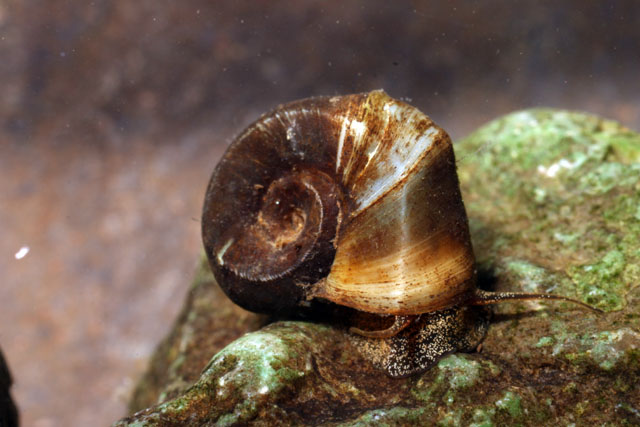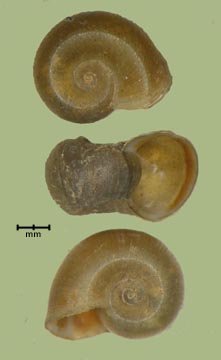> Habitat & Distribution
Helisoma anceps ranges throughout most of North America, from western Canada to Florida (Clarke 1981, Thompson 1999, Baker 1928). It is typically found in waters with at least some current, and is more common on solid substrates than its congener H. trivolvis. It is also not as typical of rich or eutrophic environments as H. trivolvis. In Atlantic drainages, populations are especially common in the Piedmont, disappearing from the Coastal Plain. In the Interior, populations of H. anceps extend from the Ohio, Tennessee, and Cumberland drainages west to the Great Plains, more common in the north, disappearing around the latitude of Kansas. FWGNA incidence rank I-5.
> Ecology & Life History
Helisoma anceps is smaller and more benthic than the better-known H. trivolvis, and hence seems more the grazer and less the browser of macrophytes. For an ecological comparison of the two species in Canada see Pip (1987). Reproduction is annual and semelparous, at least in the better-studied northern populations (Herrmann & Harman 1975, Jokinen 1985). See my essay of 9Sept20 from the link below for a figure of the juvenile shell morphology.
Like all planorbids, H. anceps supports an ample share of predators (Brown & Strouse 1988, Weber & Lodge 1990) and trematode parasites (Fernandez & Esch 1991, Esch et al. 1997, Zelmer & Esch 1998).
Jokinen s (1987) analysis of the distribution of H. anceps in Connecticut and New York led her to classify it as a C-D tramp, potentially present in nearly every community. Dillon s (2000: 360-363) reanalysis of these data suggested that H. anceps populations in Connecticut seem to be Undifferentiated with respect to life history adaptation.
> Taxonomy & Systematics
The classification of the Planorbidae proposed by the tag team of Baker (1945) and Hubendick (1955) remains, after 50 years, the basis for our understanding of this large and diverse family of pulmonates worldwide. Helisoma anceps is distinct and well-characterized in the present day. But Burch (in his note 50) listed over 25 synonyms, including antrosa, bicarinata, latchfordi, percarinatum, royalense, rushi, and sayi.
> Maps and Supplementary Resources
- Helisoma distribution in the drainage of The Ohio (2019)
- Helisoma anceps distribution in Atlantic drainages (2023)
- Helisoma distribution in Georgia and the Florida panhandle (2025)
- Helisoma distribution in the Tennessee/Cumberland (2022)
- Helisoma distribution in The Great Plains (2024)
- Pretty photo of living Helisoma anceps, courtesy of T. Travis Brown.

> Essays
- See my post to the FWGNA blog of 11Apr08 for a review of the Classification of the Planorbidae.
- Or view the (Hubendick 1955) classification of North American planorbids in a tabular format [here].
- See my post of 26Sept14 for good, comparative figures illustrating "The egg masses of freshwater pulmonate snails."
- The (rather ordinary) shell morphology demonstrated by juvenile H. anceps was compared to the (rather surprising) morphology of H. trivolvis in my essay of 9Sept90, Juvenile Helisoma.
> References
Baker, F. (1928) Freshwater Mollusca of Wisconsin, Part I, Gastropoda. Bull. Wisc. Geol. Natur. Hist. Survey, no. 70. University of Wisconsin Press, Madison.
Baker, F. (1945) The Molluscan Family Planorbidae. Urbana: University of Illinois Press.
Baker, H. B. (1946) Index to F.C. Baker's "The Molluscan Family Planorbidae." Nautilus, 59, 127-41.
Brown, K., & B. Strouse (1988) Relative vulnerability of six freshwater gastropods to the leech Nephelopsis obscura (Verrill). Freshw. Biol., 19: 157-165.
Burch, J. B. (1989) North American Freshwater Snails. Malacological Publications, Hamburg, MI. 365 pp.
Clarke, A. (1981) The Freshwater Mollusks of Canada. The National Museums of Canada, Ottawa.
Cummins, K., & G. Lauff (1969) The influence of substrate particle size on the microdistribution of stream macrobenthos. Hydrobiologia, 34: 145-181.
Dillon, R. T., Jr. (2000) The Ecology of Freshwater Molluscs. Cambridge University Press, Cambridge, England. 509 pp.
Esch, G.W., Wetzel, E.J., Zelmer, D.A. & Schotthoefer, A.M. (1997) Long-term changes in parasite population and community structure: A case history. Am. Midl. Nat. 137: 369-387.
Fernandez, J. & Esch, G.W. (1991) The component community structure of larval trematodes in the pulmonate snail Helisoma anceps. J. Parasitol. 77: 540-550.
Herrmann, S. A. & Harman, W. N. (1975) Population studies on Helisoma anceps (Menke) (Gastropoda: Planorbidae). Nautilus 89: 5-11.
Hubendick, B. (1955) Phylogeny in the Planorbidae. Trans. Zool. Soc. London 28: 453-542.
Jokinen, E. (1985) Comparative life history patterns within a littoral zone snail community. Verh. Internat. Verein, Limnol., 22: 3292-3399.
Jokinen, E. (1987) Structure of freshwater snail communities: Species-area relationships and incidence categories. Amer. Malac. Bull. 5: 9 - 19.
Laman, T., N. Boss, & H. Blankespoor (1984) Depth distribution of seven species of gastropods in Douglas Lake, Michigan. Nautilus, 98: 20-24.
Pip, E. (1987) Ecological differentiation within genus Helisoma (Gastropoda: Planorbidae) in central Canada. Nautilus101: 33-44.
Thompson, F. G. (1999) An identification manual for the freshwater snails of Florida. Walkerana 10: 1 - 96.
Weber, L.M. & Lodge, D.M. (1990) Periphytic food and predatory crayfish: Relative roles in determining snail distribution. Oecologia 82: 33-39.
Zelmer, D.A. & Esch, G.W. (1998) Bridging the GAP: The odonate naiad as a paratenic host for Halipegus occidualis (Trematoda: Hemiuridae). J. Parasitol. 84: 94-96.








